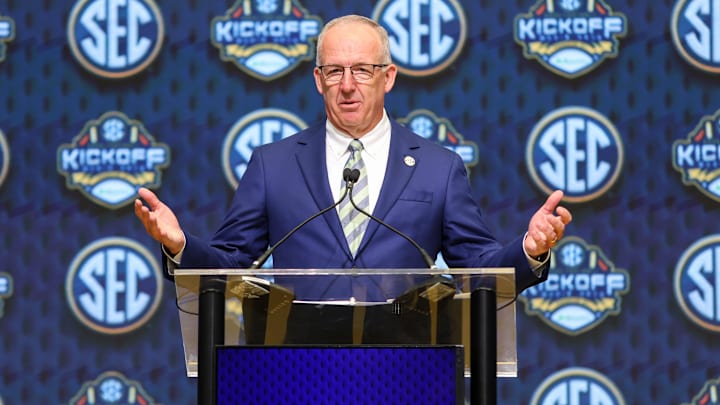Who would have thought SEC commissioner Greg Sankey might be the hero we needed for college football.
The SEC on Thursday switched from an eight-game conference schedule to nine in response to strength of schedule being a more weighted criteria when selecting teams to the College Football Playoff. The change will crank up the difficulty of schedule for all SEC members, while Sankey also put an emphasis on rivalries and big-time nonconference matchups in the move.
SEC adopts 9-game conference schedule with emphasis on rivalries
In just one announcement, Sankey and the SEC instantly fed college football fans what we've been crying for since changes in the sport ripped away traditions like rivalries, big-time unique meetings and even teams playing conference games within 1,000 miles.
The new SEC model will include a set of three opponents that a team will play every season while the other six slots will be rotated and every conference team will face off at least once every two years. The reason behind the three set matchups was to help maintain traditional rivalries, and maybe even create a few new ones while it seemed like rivalries were going extinct.
The idea of common opponents also included more common sense, as Sankey wants to make geography a factor when choosing these rivals during a time when the ACC is sending Cal across the country to play Florida State for a conference game.
Obviously the Oklahoma Sooners already have Texas as a baked in rival that meets at the same place on the same day every year. This move will add two more possible rivals to the mix, though, after Bedlam died when the Sooners left the Big 12 for the SEC.
Even if just one of OU's new rivals is based on proximity -- say Arkansas -- that's another game Sooner Nation can attend every single year no matter which campus. For some OU fans, Fayetteville could even be a shorter drive than Norman, creating the possibility of a split stadium when the Sooners and Razorbacks clash. That doesn't fully fill the void of an in-state rivalry, but it certainly helps.
Sankey also isn't letting SEC teams run from nonconference challenges like Indiana is doing in the Big Ten after sneaking into the CFP last season thanks to a soft schedule. Even with an extra SEC game on the slate, Sankey is still requiring members to include at least one nonconference game against Notre Dame or a team from a different Power Four conference (Big Ten, Big 12, ACC).
The Sooners will host Michigan Week 2 before traveling there next year. The two Blue Bloods have met only once before, creating a unique meeting that both fan bases and all college football fans have been anticipating all offseason. In the future, the Sooners will also renew a rivalry with Nebraska and have a home-and-home scheduled with Clemson.
Sankey's new requirement will force big-time nonconference games like that to live in. It would be beyond 2030 and likely wouldn't be an annual occurrence, but it could even bring back Bedlam to a football field near you.
Brent Venables and most other college football coaches (other than Indiana's Curt Cignetti) would never say it out loud, but preparing for the likes of Michigan and Clemson on top of nine SEC games is not something they'll enjoy. Double-digit win seasons, no matter how easy they come, means job security. Just ask Lincoln Riley.
For once in the last five years, though, between conference realignment, TV deals and the Transfer Portal, the fans are finally benefitting and getting what they want from a change in college football.
Read more about OU football
